
What Does Eczema Look Like?
Eczema | Eczema On Legs | Eczema On Face | Eczema On Dark Skin | Eczema Management | ProZema
What Does Eczema Look Like?
Eczema is a chronic skin condition that causes red, inflamed skin. Itching is the main symptom of eczema. Giving in to the temptation to scratch may lead to skin inflammation and can result in your skin becoming itchier. Eczema presents itself differently in everyone affected. From person to person eczema can look different, feel different, and even heal differently.
What Does Eczema Look Like On Legs?
Your legs are common place eczema presents itself in. Behind the knees seems to be a typical place due to the amount of friction and moisture that is created back there. The bacteria and sweat build-up, can worsen your eczema rash. In addition to this, irritation from any clothing that may rub against your skin and trap irritants, can also affect your eczema. The area behind the elbows tend to deal with the same issues. These body parts continue to pose challenges as they are easily accessible to itching.

What Does Eczema Look Like On The Face?
Eczema often looks red, scaly and itchy; this will vary from person to person. If not treated eczema, also known as atopic dermatitis, can cause bumps, patches, and flaking skin. It can also cause the skin to fade, darken, or become thicker. It can be tricky to pinpoint the exact cause of eczema on the face. However there are some common triggers. These may include:
- High temperatures (sweating)
- Dry air
- Humid air
- Sunlight
- Certain household chemicals
Common places on your face to get eczema would be around the eyes and on the eyelids, the cheeks, and on the neck.

What Does Eczema Look Like On Dark Skin?
According to the American Academy of Dermatology (AAD), eczema is more common in children of African and Asian descent. It is also most severe in children of African descent. In people of colour eczema may appear differently. Visually it can look “ashy”, brown, purple, or greyish in colour.
Small bumps on the skin and around hair follicles have also been noted in patients with darker skin tones. These bumps often resemble goosebumps. Darker-skinned patients also tend to experience changes in their skin colour. Itching and rubbing the skin leads to the release of melanin, which may explain hyperpigmentation during eczema flare ups.
How To Manage Eczema Naturally
There is no cure for eczema currently and there is no one remedy wonder to manage symptoms. Something that may work for one person, may not work for the next.
However, one of the first steps in managing eczema is to look into healthy changes for your everyday life. This can include but is not limited to:
- Cutting out or including certain foods into your diet
- Cleansing yourself and the surfaces you come in contact with more often
- Trying plant-based topicals
In addition to creating good everyday habits to manage your eczema from the outside, treating your eczema from the inside can be a complete game changer that is often over looked.
The gut and skin microbiome have recently been discovered to have an impaction each other. Dysbiosis, or an imbalance in the gut microbiome, leads to inflammation. This in turns worsens the inflammation of your skin. As a result, gut health has become very important in combatting atopic dermatitis.

ProZema Probiotic
ProZema is a patented blend of three unique probiotic strains:
- Bifidobacterium lactis CECT 8145,
- Bifidobacterium longum CECT 7347, and
- Lactobacillus casei CECT 9104
These strains feature antioxidant and anti-inflammatory properties and promote microbiome diversity. Together, all three strains work to relieve the itchiness and red patches characteristic of eczema and atopic dermatitis. This patented probiotic blend is all natural, vegan, and Non-GMO Project Verified.
ProZema is clinically proven to reduce the symptoms of eczema in children aged between 4 and 17 years old. A single-center, randomized, double-blind clinical research trial showed that in 96% of patients in the probiotic group, the severity of atopic dermatitis was reduced.
In addition, ProZema received the Seal of Approval from The Dermatology Review Panel which is a panel of independent dermatologists from across Canada.
Use ProZema as an adjunct therapy for your child’s eczema to reduce symptoms within 12 weeks. Available in powder form for added convenience, ProZema has a neutral taste.
Each box of ProZema has 30 sticks that you can easily snip and blend into breakfasts, lunches, and dinners. The individual sticks eliminate any risk of contamination from spoons or scoops.
Find out more about how ProZema can help with your child’s eczema symptoms here.
References:
American Academy of Dermatology: Eczema Types Atopic Dermatitis Overview
The Dermatology Review Panel: ProZema Probiotic
